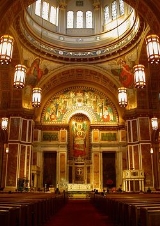
Heins & LaFarge
Encyclopedia
The New York-based architectural firm of Heins & LaFarge, composed of Philadelphia-born architect George Lewis Heins (1860–1907) and Christopher Grant LaFarge (1862–1938) - the eldest son of the artist John LaFarge
, famous especially for his stained glass panels - were responsible most notably for the original Romanesque-Byzantine east end and crossing
of the Cathedral of St. John the Divine, New York, and for the original Astor Court buildings of the Bronx Zoo
, which formed a complete ensemble reflecting the esthetic of the City Beautiful movement. Heins & Lafarge provided the architecture and details for the Interborough Rapid Transit Company
, the first subway system of New York.
and trained together in the Boston offices of Henry Hobson Richardson
. In 1886, they opened their office. Heins was the man on the site; LaFarge was the principal designer.
In 1888, a design competition for the Cathedral of St. John the Divine, the most prominent project of its kind in the US, was entered by 68 architectural firms, and won in 1891 by Heins & LaFarge, with an eclectic design, based on Romanesque forms but with many Byzantine and Gothic elements, dominated by a massive spired tower over the crossing The cornerstone was laid December 27, 1892, but unexpectedly, massive excavation was required before bedrock was hit. Heins & LaFarge completed the east end and the crossing, temporarily roofed by Rafael Guastavino
with a tiled
dome (still standing). The Chapel of St. Columba was consecrated in 1911, but the death of Heins impelled the Cathedral trustees to hire a new architect Ralph Adams Cram
, whose nave and west front would be continued in French Gothic style
.
The other prime commission in New York City was the Fourth Presbyterian Church (1893–94), now Annunciation Greek Orthodox Church
, at West End Avenue
and West 91st Street on the Upper West Side
, a tribute to their joint master. The rusticated masonry façade with a sparing use of Venetian Gothic and Richardsonian Romanesque
details and the square corner bell tower with a crenellated parapet embellished with gargoyle gutter-spouts reveal Richardson's training. Fine stained glass may be from Tiffany studios, or may be by John LaFarge
, the architect's father, which would make them even rarer.
An exercise in a somewhat subdued Richardsonian manner, in the Bedford-Stuyvesant district of Brooklyn
, is Heins & LaFarge's Reformed Episcopal Church of the Reconciliation (1890), now the Most Worshipful Enoch Grand Lodge of the Order of Masons
. It too has a corner tower that is octagonal and embedded in the volume of the church in a most Richardsonian manner, though the materials used are tame, brick, now painted, rather than Richardsonian rustication.
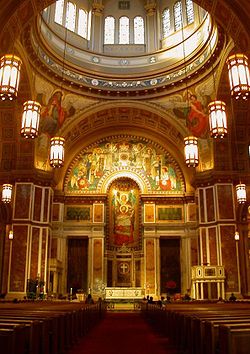 In Washington DC, the church, now Cathedral of St. Matthew the Apostle
In Washington DC, the church, now Cathedral of St. Matthew the Apostle
, was begun in 1893, to designs of LaFarge. It is a brick structure of an abbreviated Latin cross floorplan with such a prominent crossing dome, raised on an octagonal drum lit by ranges of arch-headed windows, that has something of the aspect of a centrally-planned Greek cross. The interior is rich with frescoes and mosaics and inlaid marble floors in full American Renaissance
manner. The first mass was celebrated on June 2, 1895, and the completed church was dedicated in 1913. The firm designed other notable Catholic Churches including the Church of the Blessed Sacrament, Providence RI and Holy Trinity Church, West Point, NY.
, and he designed interiors for the first buildings at the State University of New York
, Albany: the Auditorium and the Science and Administration Buildings. He held that position until his death in 1907. While serving in that capacity his office designed the Flushing Armory
, Geneva Armory
, Gloversville Armory
, Medina Armory
, Rochester Armory, and Oneonta Armory
.
 LaFarge, a fellow of the American Institute of Architects
LaFarge, a fellow of the American Institute of Architects
(AIA) often served on advisory committees for the schools of architecture at Columbia University, M.I.T. and Princeton University, and also as trustee and secretary for the American Academy in Rome
.
Roosevelt was also a prime mover behind the creation of the New York Zoological Society
, for whom the partners designed the original nucleus of buildings (1899–1910, now called the Astor Court) as a series of pavilions symmetrically grouped round the large sea lion pool, all in a sturdy brick and limestone Roman Ionic
and Doric
, with the heads of elephants and rhinos, lions and zebras projecting festively from panels and friezes. The central Administration Building (1910), offering an arched passageway to the zoo's outdoor spaces, has complicated domed spaces formed of Guastavino tile
.
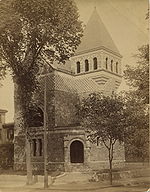 University commissions were also in their oeuvre. At Yale
University commissions were also in their oeuvre. At Yale
, their rusticated Richardsonian Romanesque
design for a chapter building of St. Anthony Hall
, also known as the Delta Psi fraternity, stood from 1894 to 1913. Their ornamental iron gates were re-used in the 1913 successor by Charles C. Haight
. Original building described in http://books.google.com/books?id=alnup81pmkAC&pg=PA123&lpg=PA123&dq=patrick+pinnell+yale+anthony&source=web&ots=Mzn6w25dre&sig=KRPoISsYFKMPZl6SIOhSU_aDMtE and pictured at: http://www.yalealumnimagazine.com/issues/01_03/popup/landmarks/22.html Later building with re-used gates at http://www.facilities.yale.edu/images/BFS/9502.jpg In 1899 Heins & LaFarge built the Houghton Memorial Chapel at Wellesley College, Wellesley, Massachusetts, Richardsonian in its recessed entrance, dominating central tower and interpenetrating Romanesque massing. Also in 1899, at the United States Military Academy
, West Point
, they erected the Roman Catholic chapel of the Most Holy Trinity, also hearkening back to their Richardson apprenticeship with an essay in rusticated granite, with a battlemented corner tower and a heavy arcaded porch. It was enlarged in 1959.
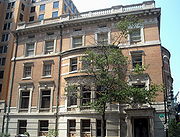
In 1904 they were commissioned to design the Roman Catholic Cathedral of St James in Seattle by Bishop Edward J. O’Dea, whose diocese had purchased property on Seattle’s First Hill and demanded a cathedral “that must surpass anything in the West.” The Italian quattrocento design features tall, paired campanili
at the west end and a central dome. The firm sent two young architects, W. Marbury Somervell and Joseph S. Coté, to oversee construction on the site, who went on to establish a thriving architectural practice in Seattle. The cornerstone ceremony took place on November 12, 1905. The cathedral was completed in 1907 and solemnly dedicated on December 22, 1907. Unhappily, under the weight of two feet of wet snow the dome collapsed on the afternoon of February 2, 1916, dropping 400 tons of masonry eighty feet into the empty cathedral, shattering every window and leaving a gaping hole that exposed it to the elements. The cathedral reopened on March 18, 1917, but with a flat roof over the crossing. The central repositioning of the altar in response to reforms of the Second Vatican Council
has finally brought it into the position envisaged by the architects.
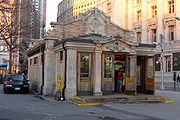 Beginning in 1901, Heins & LaFarge designed subway stations and buildings for the Interborough Rapid Transit Company
Beginning in 1901, Heins & LaFarge designed subway stations and buildings for the Interborough Rapid Transit Company
under the direction of the chief engineer, William Barclay Parsons. When the Interborough Rapid Transit opened on October 27, 1904, its showpiece station was City Hall
, designed by Heins & LaFarge using uninterrupted sweeping Guastavino-tiled arches and vaults which incorporated shaped skylights and mosaics and polychrome terracotta panels
. Throughout the original stations the polychrome faience panels (from Grueby Faience Company
, Boston, and Atlantic Terra Cotta Company
of Staten Island and New Jersey) were designed by the firm. The partners' control house for the IRT is at Bowling Green
at the corner of Battery Park in the Dutch Renaissance manner reminiscent of New Amsterdam
. A few Heins & Lafarge subway entrances survive, notably at 72nd Street (Broadway). Lafarge was replaced by Squire J. Vickers as architect in charge in 1908.
John LaFarge
John La Farge was an American painter, muralist, stained glass window maker, decorator, and writer.-Biography:...
, famous especially for his stained glass panels - were responsible most notably for the original Romanesque-Byzantine east end and crossing
Crossing (architecture)
A crossing, in ecclesiastical architecture, is the junction of the four arms of a cruciform church.In a typically oriented church , the crossing gives access to the nave on the west, the transept arms on the north and south, and the choir on the east.The crossing is sometimes surmounted by a tower...
of the Cathedral of St. John the Divine, New York, and for the original Astor Court buildings of the Bronx Zoo
Bronx Zoo
The Bronx Zoo is located in the Bronx borough of New York City, within Bronx Park. It is the largest metropolitan zoo in the United States, comprising of park lands and naturalistic habitats, through which the Bronx River flows....
, which formed a complete ensemble reflecting the esthetic of the City Beautiful movement. Heins & Lafarge provided the architecture and details for the Interborough Rapid Transit Company
Interborough Rapid Transit Company
The Interborough Rapid Transit Company was the private operator of the original underground New York City Subway line that opened in 1904, as well as earlier elevated railways and additional rapid transit lines in New York City. The IRT was purchased by the City in June 1940...
, the first subway system of New York.
Early career
The two young men met at Massachusetts Institute of TechnologyMassachusetts Institute of Technology
The Massachusetts Institute of Technology is a private research university located in Cambridge, Massachusetts. MIT has five schools and one college, containing a total of 32 academic departments, with a strong emphasis on scientific and technological education and research.Founded in 1861 in...
and trained together in the Boston offices of Henry Hobson Richardson
Henry Hobson Richardson
Henry Hobson Richardson was a prominent American architect who designed buildings in Albany, Boston, Buffalo, Chicago, Pittsburgh, and other cities. The style he popularized is named for him: Richardsonian Romanesque...
. In 1886, they opened their office. Heins was the man on the site; LaFarge was the principal designer.
In 1888, a design competition for the Cathedral of St. John the Divine, the most prominent project of its kind in the US, was entered by 68 architectural firms, and won in 1891 by Heins & LaFarge, with an eclectic design, based on Romanesque forms but with many Byzantine and Gothic elements, dominated by a massive spired tower over the crossing The cornerstone was laid December 27, 1892, but unexpectedly, massive excavation was required before bedrock was hit. Heins & LaFarge completed the east end and the crossing, temporarily roofed by Rafael Guastavino
Rafael Guastavino
Rafael Guastavino Moreno was a Valencian architect and builder, creator of the Guastavino tile, a "Tile Arch System" patented in the US in 1885. It is a technique for constructing robust, self-supporting arches and architectural vaults using interlocking terracotta tiles and layers of mortar...
with a tiled
Guastavino tile
Guastavino tile is the "Tile Arch System" patented in the US in 1885 by Valencian architect and builder Rafael Guastavino...
dome (still standing). The Chapel of St. Columba was consecrated in 1911, but the death of Heins impelled the Cathedral trustees to hire a new architect Ralph Adams Cram
Ralph Adams Cram
Ralph Adams Cram FAIA, , was a prolific and influential American architect of collegiate and ecclesiastical buildings, often in the Gothic style. Cram & Ferguson and Cram, Goodhue & Ferguson are partnerships in which he worked.-Early life:Cram was born on December 16, 1863 at Hampton Falls, New...
, whose nave and west front would be continued in French Gothic style
Gothic architecture
Gothic architecture is a style of architecture that flourished during the high and late medieval period. It evolved from Romanesque architecture and was succeeded by Renaissance architecture....
.
The other prime commission in New York City was the Fourth Presbyterian Church (1893–94), now Annunciation Greek Orthodox Church
Annunciation Greek Orthodox Church (Manhattan)
The Annunciation Greek Orthodox Church is a Greek Orthodox church on Manhattan's Upper West Side at West End Avenue and West 91st Street.-History:The church was built by Heins & LaFarge in as the Fourth Presbyterian Church...
, at West End Avenue
West End Avenue
West End Avenue is a north-south thoroughfare on the West Side of the borough of Manhattan in New York City, not far from the Hudson River.West End Avenue originates at West 59th Street; the continuation of the street below 59th Street is called Eleventh Avenue. It runs from 59th Street to its...
and West 91st Street on the Upper West Side
Upper West Side
The Upper West Side is a neighborhood in the borough of Manhattan, New York City, that lies between Central Park and the Hudson River and between West 59th Street and West 125th Street...
, a tribute to their joint master. The rusticated masonry façade with a sparing use of Venetian Gothic and Richardsonian Romanesque
Richardsonian Romanesque
Richardsonian Romanesque is a style of Romanesque Revival architecture named after architect Henry Hobson Richardson, whose masterpiece is Trinity Church, Boston , designated a National Historic Landmark...
details and the square corner bell tower with a crenellated parapet embellished with gargoyle gutter-spouts reveal Richardson's training. Fine stained glass may be from Tiffany studios, or may be by John LaFarge
John LaFarge
John La Farge was an American painter, muralist, stained glass window maker, decorator, and writer.-Biography:...
, the architect's father, which would make them even rarer.
An exercise in a somewhat subdued Richardsonian manner, in the Bedford-Stuyvesant district of Brooklyn
Brooklyn
Brooklyn is the most populous of New York City's five boroughs, with nearly 2.6 million residents, and the second-largest in area. Since 1896, Brooklyn has had the same boundaries as Kings County, which is now the most populous county in New York State and the second-most densely populated...
, is Heins & LaFarge's Reformed Episcopal Church of the Reconciliation (1890), now the Most Worshipful Enoch Grand Lodge of the Order of Masons
Freemasonry
Freemasonry is a fraternal organisation that arose from obscure origins in the late 16th to early 17th century. Freemasonry now exists in various forms all over the world, with a membership estimated at around six million, including approximately 150,000 under the jurisdictions of the Grand Lodge...
. It too has a corner tower that is octagonal and embedded in the volume of the church in a most Richardsonian manner, though the materials used are tame, brick, now painted, rather than Richardsonian rustication.

Cathedral of St. Matthew the Apostle
The Cathedral of St. Matthew the Apostle in Washington D.C., most commonly known as St. Matthew's Cathedral, is the seat of the Archbishop of the Roman Catholic Archdiocese of Washington. As St...
, was begun in 1893, to designs of LaFarge. It is a brick structure of an abbreviated Latin cross floorplan with such a prominent crossing dome, raised on an octagonal drum lit by ranges of arch-headed windows, that has something of the aspect of a centrally-planned Greek cross. The interior is rich with frescoes and mosaics and inlaid marble floors in full American Renaissance
American Renaissance
In the history of American architecture and the arts, the American Renaissance was the period in 1835-1880 characterized by renewed national self-confidence and a feeling that the United States was the heir to Greek democracy, Roman law, and Renaissance humanism...
manner. The first mass was celebrated on June 2, 1895, and the completed church was dedicated in 1913. The firm designed other notable Catholic Churches including the Church of the Blessed Sacrament, Providence RI and Holy Trinity Church, West Point, NY.
Mid career
In 1899, Heins was appointed New York State architect by Governor Theodore RooseveltTheodore Roosevelt
Theodore "Teddy" Roosevelt was the 26th President of the United States . He is noted for his exuberant personality, range of interests and achievements, and his leadership of the Progressive Movement, as well as his "cowboy" persona and robust masculinity...
, and he designed interiors for the first buildings at the State University of New York
State University of New York
The State University of New York, abbreviated SUNY , is a system of public institutions of higher education in New York, United States. It is the largest comprehensive system of universities, colleges, and community colleges in the United States, with a total enrollment of 465,000 students, plus...
, Albany: the Auditorium and the Science and Administration Buildings. He held that position until his death in 1907. While serving in that capacity his office designed the Flushing Armory
Flushing Armory
The Flushing Armory is a historic National Guard armory building located in the Flushing section of the New York City borough of Queens. It is a brick and stone castle-like structure built in 1905–1906, designed to be reminiscent of medieval military structures in Europe. It was designed by State...
, Geneva Armory
Geneva Armory
Geneva Armory is a historic National Guard armory building located at Geneva in Ontario County, New York. The armory consists of a long, shallow, rectangular, five-story, hip-roofed administration building with an attached -story, rectangular gable-roofed drill shed. The original section of the...
, Gloversville Armory
Gloversville Armory
Gloversville Armory is a historic National Guard armory building located at Gloversville in Fulton County, New York. It is a brick and red sandstone castle-like structure built in 1903-1904, designed to be reminiscent of medieval military structures in Europe. It was designed by State Architect...
, Medina Armory
Medina Armory
The Medina Armory is located on Pearl Street in Medina, New York, United States. It is a large stone building constructed at the beginning of the 20th century....
, Rochester Armory, and Oneonta Armory
Oneonta Armory
Oneonta Armory is a historic National Guard armory building located at Oneonta in Otsego County, New York. It is a brick and stone castle-like structure built in 1905. It was designed by State architect George L. Heins. It consists of a two-story administration building with an attached drill shed...
.

American Institute of Architects
The American Institute of Architects is a professional organization for architects in the United States. Headquartered in Washington, D.C., the AIA offers education, government advocacy, community redevelopment, and public outreach to support the architecture profession and improve its public image...
(AIA) often served on advisory committees for the schools of architecture at Columbia University, M.I.T. and Princeton University, and also as trustee and secretary for the American Academy in Rome
American Academy in Rome
The American Academy in Rome is a research and arts institution located on the Gianicolo in Rome.- History :In 1893, a group of American architects, painters and sculptors met regularly while planning the fine arts section of the 1893 World's Columbian Exposition...
.
Roosevelt was also a prime mover behind the creation of the New York Zoological Society
Wildlife Conservation Society
The Wildlife Conservation Society based at the Bronx Zoo was founded in 1895 as the New York Zoological Society and currently manages some of wild places around the world, with over 500 field conservation projects in 60 countries, and 200 scientists on staff...
, for whom the partners designed the original nucleus of buildings (1899–1910, now called the Astor Court) as a series of pavilions symmetrically grouped round the large sea lion pool, all in a sturdy brick and limestone Roman Ionic
Ionic order
The Ionic order forms one of the three orders or organizational systems of classical architecture, the other two canonic orders being the Doric and the Corinthian...
and Doric
Doric order
The Doric order was one of the three orders or organizational systems of ancient Greek or classical architecture; the other two canonical orders were the Ionic and the Corinthian.-History:...
, with the heads of elephants and rhinos, lions and zebras projecting festively from panels and friezes. The central Administration Building (1910), offering an arched passageway to the zoo's outdoor spaces, has complicated domed spaces formed of Guastavino tile
Guastavino tile
Guastavino tile is the "Tile Arch System" patented in the US in 1885 by Valencian architect and builder Rafael Guastavino...
.

YALE
RapidMiner, formerly YALE , is an environment for machine learning, data mining, text mining, predictive analytics, and business analytics. It is used for research, education, training, rapid prototyping, application development, and industrial applications...
, their rusticated Richardsonian Romanesque
Richardsonian Romanesque
Richardsonian Romanesque is a style of Romanesque Revival architecture named after architect Henry Hobson Richardson, whose masterpiece is Trinity Church, Boston , designated a National Historic Landmark...
design for a chapter building of St. Anthony Hall
St. Anthony Hall
St. Anthony Hall, also known as Saint Anthony Hall and The Order of St. Anthony, is a national college literary society also known as the Fraternity of Delta Psi at colleges in the United States of America. St...
, also known as the Delta Psi fraternity, stood from 1894 to 1913. Their ornamental iron gates were re-used in the 1913 successor by Charles C. Haight
Charles C. Haight
Charles Coolidge Haight was an American architect who practiced in New York City. A number of his buildings survive including at Yale University and Trinity College . He also designed most of the campus of the Episcopal General Theological Seminary in Chelsea Square, New York...
. Original building described in http://books.google.com/books?id=alnup81pmkAC&pg=PA123&lpg=PA123&dq=patrick+pinnell+yale+anthony&source=web&ots=Mzn6w25dre&sig=KRPoISsYFKMPZl6SIOhSU_aDMtE and pictured at: http://www.yalealumnimagazine.com/issues/01_03/popup/landmarks/22.html Later building with re-used gates at http://www.facilities.yale.edu/images/BFS/9502.jpg In 1899 Heins & LaFarge built the Houghton Memorial Chapel at Wellesley College, Wellesley, Massachusetts, Richardsonian in its recessed entrance, dominating central tower and interpenetrating Romanesque massing. Also in 1899, at the United States Military Academy
United States Military Academy
The United States Military Academy at West Point is a four-year coeducational federal service academy located at West Point, New York. The academy sits on scenic high ground overlooking the Hudson River, north of New York City...
, West Point
West Point, New York
West Point is a federal military reservation established by President of the United States Thomas Jefferson in 1802. It is a census-designated place located in Town of Highlands in Orange County, New York, United States. The population was 7,138 at the 2000 census...
, they erected the Roman Catholic chapel of the Most Holy Trinity, also hearkening back to their Richardson apprenticeship with an essay in rusticated granite, with a battlemented corner tower and a heavy arcaded porch. It was enlarged in 1959.

End of career
In 1903 Heins & LaFarge were commissioned to design the Municipal Building for Washington DC.In 1904 they were commissioned to design the Roman Catholic Cathedral of St James in Seattle by Bishop Edward J. O’Dea, whose diocese had purchased property on Seattle’s First Hill and demanded a cathedral “that must surpass anything in the West.” The Italian quattrocento design features tall, paired campanili
Campanile
Campanile is an Italian word meaning "bell tower" . The term applies to bell towers which are either part of a larger building or free-standing, although in American English, the latter meaning has become prevalent.The most famous campanile is probably the Leaning Tower of Pisa...
at the west end and a central dome. The firm sent two young architects, W. Marbury Somervell and Joseph S. Coté, to oversee construction on the site, who went on to establish a thriving architectural practice in Seattle. The cornerstone ceremony took place on November 12, 1905. The cathedral was completed in 1907 and solemnly dedicated on December 22, 1907. Unhappily, under the weight of two feet of wet snow the dome collapsed on the afternoon of February 2, 1916, dropping 400 tons of masonry eighty feet into the empty cathedral, shattering every window and leaving a gaping hole that exposed it to the elements. The cathedral reopened on March 18, 1917, but with a flat roof over the crossing. The central repositioning of the altar in response to reforms of the Second Vatican Council
Second Vatican Council
The Second Vatican Council addressed relations between the Roman Catholic Church and the modern world. It was the twenty-first Ecumenical Council of the Catholic Church and the second to be held at St. Peter's Basilica in the Vatican. It opened under Pope John XXIII on 11 October 1962 and closed...
has finally brought it into the position envisaged by the architects.

Interborough Rapid Transit Company
The Interborough Rapid Transit Company was the private operator of the original underground New York City Subway line that opened in 1904, as well as earlier elevated railways and additional rapid transit lines in New York City. The IRT was purchased by the City in June 1940...
under the direction of the chief engineer, William Barclay Parsons. When the Interborough Rapid Transit opened on October 27, 1904, its showpiece station was City Hall
City Hall (IRT Lexington Avenue Line)
City Hall, also known as City Hall Loop, was the original southern terminal station of the first line of the New York City Subway, built by the Interborough Rapid Transit Company , named the "Manhattan Main Line", and now part of the IRT Lexington Avenue Line...
, designed by Heins & LaFarge using uninterrupted sweeping Guastavino-tiled arches and vaults which incorporated shaped skylights and mosaics and polychrome terracotta panels
New York City subway tiles
Many New York City Subway stations are decorated with colorful ceramic plaques and tile mosaics. Of these, many take the form of signs, identifying the station's location. Much of this ceramic work was in place when the subway system originally opened on October 27, 1904...
. Throughout the original stations the polychrome faience panels (from Grueby Faience Company
Grueby Faience Company
The Grueby Faience Company, founded in 1894, was an American ceramics company that produced distinctive vases and tiles during America's Arts and Crafts Movement....
, Boston, and Atlantic Terra Cotta Company
A. Hall and Sons Terra Cotta
A. Hall and Sons Terra Cotta was founded in 1846 in Perth Amboy, New Jersey due to Perth Amboy's rich supplies of clay. It was one of the first successful terra cotta plants in the United States. Originally, the manufactory produced porcelain and household wares but transitioned to terra cotta...
of Staten Island and New Jersey) were designed by the firm. The partners' control house for the IRT is at Bowling Green
Bowling Green (New York City)
Bowling Green is a small public park in Lower Manhattan at the foot of Broadway next to the site of the original Dutch fort of New Amsterdam. Built in 1733, originally including a bowling green, it is the oldest public park in New York City and is surrounded by its original 18th century fence. At...
at the corner of Battery Park in the Dutch Renaissance manner reminiscent of New Amsterdam
New Amsterdam
New Amsterdam was a 17th-century Dutch colonial settlement that served as the capital of New Netherland. It later became New York City....
. A few Heins & Lafarge subway entrances survive, notably at 72nd Street (Broadway). Lafarge was replaced by Squire J. Vickers as architect in charge in 1908.
External links
- New York Architectural Images: Heins & LaFarge
- Society of Architectural Historians: Heins & LaFarge
- Greek Orthodox Church of the Annunciation (built as the Fourth Presbyterian Church)
- Short History of St James Cathedral
- History Link: "Snow collapses church dome in Seattle and stops rail service in Western Washington on February 2, 1916"
- Bowling Green subway kiosk
- U.S.M.A. Catholic Chapel
- Forgotten-New York:City Hall station

